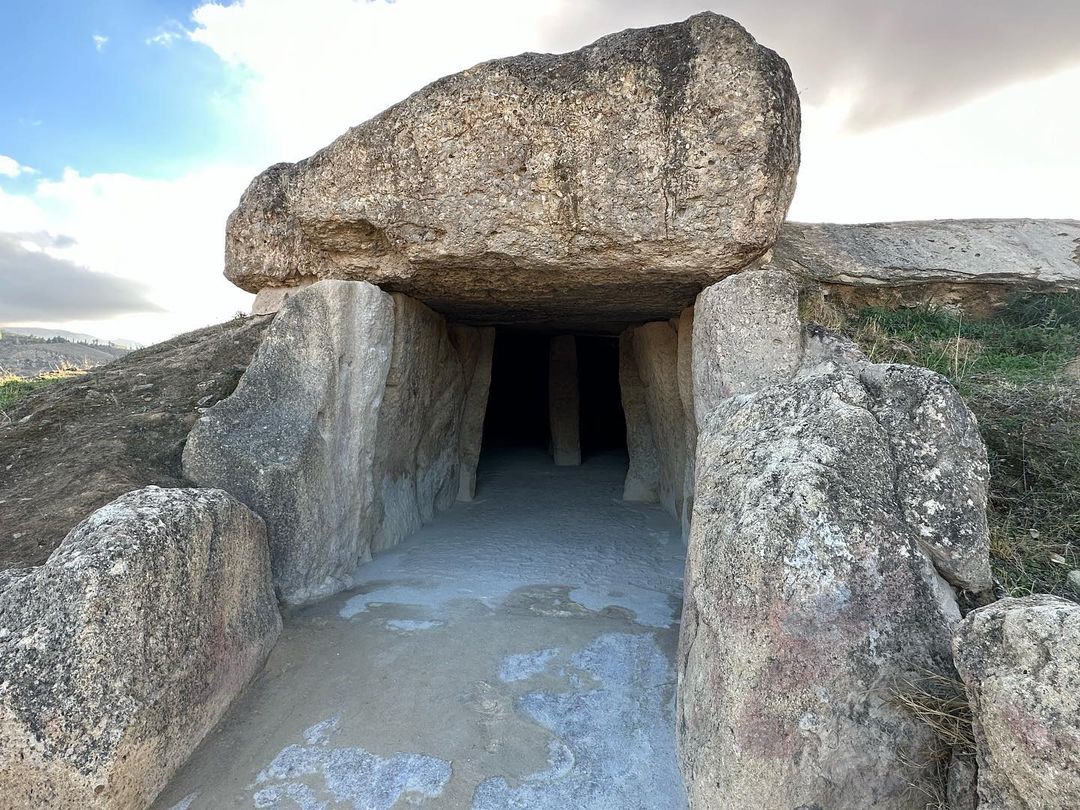Sign up for CNN’s Wonder Theory science newsletter. Explore the universe with news on fascinating discoveries, scientific advancements and more.
CNN —
Each of the 32 colossal stones that make up the Menga Dolmen, a 5,600-year-old megalithic monument in southern Spain, is many times bigger than the largest megaliths at Stonehenge, the most famous Neolithic wonder.
Embedded in the ground on a hilltop that rises about 50 meters (165 feet) above the surrounding plain, the stones form a dolmen, or single-chamber tomb, about 25 meters (82 feet) long and 5 meters (16.4 feet) wide at the widest point. The largest single stone weighs around 150 metric tons, about the same as a blue whale and nearly five times heavier than Stonehenge’s largest component. Collectively, the megaliths weigh about 1,140 metric tons.
Related articleCentury-old theory of where Stonehenge’s Altar Stone came from overturned by new study
“I tell the students in my lectures … the weight is more than two Boeing 747 airplanes combined, the ones that fly across continents and so on, fully loaded with fuel and passengers,” said Leonardo García Sanjuán, a coauthor of a new study on the monument and a professor of prehistory at Spain’s University of Seville.
“It’s a huge, enormous amount of stone, and it’s always been a mystery and an intriguing scientific question how on Earth (it was built given) the technology they had in the Neolithic period.”
The results of a decade-long research project published Friday in the journal Science Advances attempt to answer this question, revealing the surprisingly sophisticated engineering skills needed to accomplish such a feat.
“I’d noticed that its stones were carefully placed without gaps but this paper reveals just how precisely that has to have been done, with an extraordinary eye on the dimensions and angles,” said Mike Parker-Pearson, a professor of British later prehistory at University College London, who described it as “one of the world’s greatest megalithic wonders.” Parker-Pearson wasn’t involved in the research.
How to build a megalith
The project, led by José Antonio Lozano Rodríguez, a geologist at the Canary Islands Oceanographic Center, pieced together how the stones were cut, transported and placed by looking at the topography and geology of the site, information from previous archaeological excavations, and ethnographic and historical accounts of building techniques.
The upright stones that make up the walls of the chamber were not perfectly vertical, tilting inward at a gentle angle to make the building narrower at the roof than at the floor and creating a trapezoid-shaped chamber.
The team calculated that each of the upright stones lean inward at a largely uniform angle of 84 to 85 degrees. The upright stones that form the walls also lean sideways against one another at a consistent angle. The architect and builders must have used tools such as plumb levels and framing squares to achieve such consistency and accuracy, the study said.
A total of 32 stones were moved to the site from a quarry less than a mile away before being erected.
Miguel Ángel Blanco de la Rubia
“The precision of the angles is millimetric,” García Sanjuán said. “They made a Tetris out of this, like the computer game.”
He added, “The stones were placed and carved so that they would be slightly inclined and perfectly adjusted to each other. Each block has to fit exactly with the others, and each block supports the others. All the stones are locked into one another and embedded into the bedrock.”
A unique feature of the monument revealed by the study showed how the upright stones were initially embedded, likely with the use of a counterweight, into foundation sockets so deep that up to one-third of the stones would have been below ground when first erected.
Once the walls had been completed, the builders placed five huge capstones to form the roof. The builders subsequently removed the earth to the desired floor level, erecting stone pillars for extra support.
“Once the capstones were added, it was like a solid box, with the bedrock still inside, and then they carved away all that rock, all that bedrock, to make the chamber,” García Sanjuán said.
The resulting building was then covered with a mound of soil, which would have insulated the chamber from cold and wet weather, as well as acting as a “straitjacket” to add stability to the construction, he added.
Related articleAncient DNA reveals possible cause of mysterious population collapse 5,000 years ago, scientists say
García Sanjuán said it’s not exactly clear how the dolmen was used, most likely as a temple and tomb, though few archaeological remains have been found within the relic. The paper suggested that one reason it was constructed to withstand the ages was because the region is seismically active.
Parker-Pearson said its makers wanted to create a solid structure that lasted for eternity.
“Although the authors of the Menga paper suggest this might be something to resist earthquake damage, I think there’s a more significant reason why stone monuments such as Menga, Stonehenge and many others were built so solidly, which is the attempt at permanence,” he said.
“This linking of stone with the eternal is something which I think is a feature shared by all the prehistoric megalithic dolmens (and other tombs) of western Europe,” he added.
“In the majority of cases these are tombs and dolmens for the dead, housing in perpetuity the ancestors who were also considered eternal.”
How did they transport the rocks?
Research published in December 2023 by the same team identified the source of the stones used to build the monument: a quarry 850 meters (0.5 mile) away, some 50 meters (164 feet) higher than the location of Menga — favorable topography that would have allowed for the transport of the massive stones down a gentle slope.
This study suggested that the builders would likely have designed a trackway or road to minimize friction of the relatively soft rock against the ground by embedding closely spaced timber poles or planks into the ground and transporting the stones using huge wooden sledges controlled with large ropes.
The Menga Dolmen sits atop a hill near Antequera, Spain.
Leonardo García Sanjuán
The dolmen was also built on a similar descending path from the back of the chamber to the entrance, enabling the stones to move along the same axis during the construction process.
“These new insights into the engineering skills confirm, along with the size of the dolmen’s massive stones, that these people of Iberia’s early Copper Age were intent on constructing a super-solid monument,” Parker-Pearson said via email.
“With such big stones, they couldn’t have afforded to make mistakes when manoeuvring them into position — if even just one was a few centimetres out, that would have been hard to correct once an upright stone was set in its construction trench.”
The new study described the Menga Dolmen as a one-of-a-kind example of “creative genius” and “early science” in a Neolithic society, a time when agriculture recently was adopted as a way of life and tools were made largely of stone and other natural materials rather than metal, and no written language existed.
Related articleArchaeologists unearth tiny 3,500-year-old clay tablet following an earthquake
“You see that these people knew about physics, friction, angles. They knew about geology. They knew the properties of the rocks, they knew about geometry,“ García Sanjuán said.
“Put these things together (and) what do you have? We have to call it science. We’ve never talked about Neolithic science before only because we are too arrogant to think that these people could do science the way we do it.”
“If any engineer today tried to build Menga with the resources that existed 6,000 years ago, I don’t think they could do it.”





















